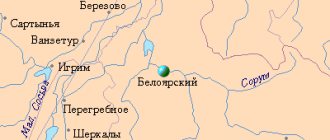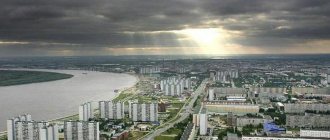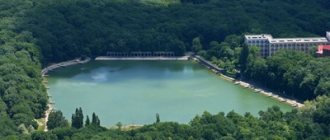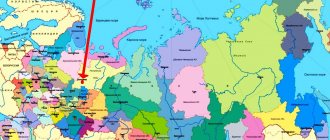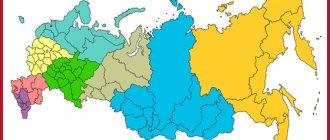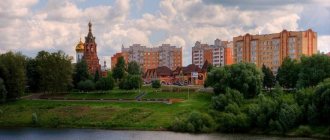TASS DOSSIER. On December 13, 2022, Russian President Vladimir Putin signed a decree moving the capital of the Far Eastern Federal District (FEFD) from Khabarovsk to Vladivostok.
This document amends the list of federal districts and their capitals, approved by decree of the head of state of May 13, 2000.
On October 6, 2022, the initiative to move the center of the Far Eastern Federal District to Vladivostok was made by the acting governor of the Primorsky Territory Oleg Kozhemyako. On October 9, the Presidential Envoy to the Far East, Deputy Prime Minister of the Russian Federation Yuri Trutnev said that this proposal would be submitted to the head of state by the end of the year.
On December 10, the press secretary of the Russian President Dmitry Peskov said that Vladimir Putin approved the transfer of the district capital from Khabarovsk to Vladivostok.
How federal districts and their centers have changed
The center of the federal district is a settlement in which the plenipotentiary representative of the head of state, his apparatus, and various coordinating bodies are located. In addition, departments of federal ministries and departments may be created in the capitals of federal districts. Decisions on their establishment are made by government agencies themselves.
Federal districts were established on May 13, 2000 by decree of Putin. Initially, seven federal districts were formed with centers in large cities: Central Federal District (center - Moscow), North-Western (St. Petersburg), North Caucasus (Rostov-on-Don), Volga (Nizhny Novgorod), Ural (Ekaterinburg) ), Siberian (Novosibirsk) and Far Eastern (Khabarovsk).
On June 21, 2000, the North Caucasus District was renamed the Southern District, while the center of the district remained in Rostov-on-Don. On January 19, 2010, a separate North Caucasus Federal District with its center in Pyatigorsk, Stavropol Territory, was separated from the Southern District.
On March 21, 2014, in connection with the formation of new subjects of the Federation - the Republic of Crimea and the federal city of Sevastopol - the Crimean Federal District was created with its center in Simferopol. On July 28, 2016, by decree of the head of state, the Crimean District was liquidated, and the constituent entities of the Russian Federation previously included in it were transferred to the Southern Federal District. On November 3, 2022, Buryatia and the Trans-Baikal Territory were withdrawn from the Siberian District and included in the Far Eastern Region.
Currently, there are eight federal districts in Russia. Almost all of their centers are located in the capitals of the constituent entities of the Federation or cities of federal significance. The exception is the North Caucasus Federal District with its capital in Pyatigorsk.
Far Eastern Federal District
Far Eastern Federal District (FEFD) is a federal district in the east of the Asian part of Russia; one of the eight federal districts of the Russian Federation. The administrative center is Khabarovsk.
Most of the territory of the federal district is occupied by plateaus, highlands and ridges - the Chersky and Dzhudzhur ridges, the Verkhoyansk ridge, the Kolyma and Chukotka highlands and others in the northeast (North-East Russia), the Stanovoy ridge, Sikhote-Alin and other ridges in the southeast (Amur-Primorsky-Sakhalin country), in the east - the ridges of the Kamchatka Peninsula, characterized by increased volcanic activity (Koryak-Kamchatka-Kuril country). Lowlands make up less than a quarter of the area of the Far East, occupying coastal territories or narrow intermountain spaces in the east. In the west are the vast Vilyuiskoye and Prilenskoye plateaus. A significant part of the territory of the Far Eastern Federal District is located in the Far North and permafrost regions. From the north, the territory of the district is washed by the waters of the seas of the Arctic Ocean (Laptev, East Siberian and Chukotka), from the west - by the waters of the Pacific Ocean (Bering, Okhotsk and Japan).
The territory of the district is 6,169,329 km2, the population (as of January 1, 2022) is 6,182,679 people. The Far Eastern Federal District is the largest and most sparsely populated federal district in Russia.
The Far Eastern Federal District includes 2 republics (Buryatia and Sakha (Yakutia)), 4 territories (Transbaikal, Kamchatka, Primorsky and Khabarovsk), 3 regions (Amur, Magadan and Sakhalin), 1 autonomous region (Jewish) and 1 autonomous district (Chukotka ). The Republic of Buryatia and the Trans-Baikal Territory have been included in the Far Eastern Federal District since November 3, 2022. All data in the article is for the period before the specified date.
Surface water resources
The water resources of the district are represented by a river network with a length of over 4.047 million km (the density of the river network is 0.66 km/km2 - from 0.5 km/km2 in Yakutia to 1.07 km/km2 in the Sakhalin region), lakes and artificial reservoirs with an area of more than 112 thousand km2 (lake content 1.82% - from 0.22% in the Jewish Autonomous Region to 2.76% in the Sakhalin Region), swamps and wetlands with a total area of over 423 thousand km2 (swampiness 6.87% - from 2. 81% in the Primorsky Territory to 25.21% in the Jewish Autonomous Region). The Far Eastern Federal District ranks first in terms of the length of the river network and the area of swamps and wetlands; second place in terms of density of the river network after the North-West and the area of lakes and artificial reservoirs after the Siberian Federal District.
The average long-term river flow is 1847.8 km3/year, the highest figure among the federal districts of Russia. Yakutia is the most endowed with river resources (881.1 km3/year - the second region in Russia in terms of average long-term river flow after the Krasnoyarsk Territory), the least - Primorsky Territory (46.2 km3/year). In 2015, river flow in the Far Eastern Federal District amounted to 1924.8 km3/year, which is 4.15% higher than the long-term average. Below is the dynamics of river flow in the Far Eastern Federal District from 2010 to 2015.
Yakutia and Primorye also became the most and least endowed with surface water resources in 2015 (911.8 km3/year and 70.9 km3/year, respectively). The change in water content in the regions of the district relative to the long-term average is different - from +53.13% in the Primorsky Territory to -17.82% in the Jewish Autonomous Region. Among the federal districts of Russia, the Far Eastern Federal District ranks first in terms of average long-term river flow and river flow in 2015. Below is the deviation of river flow in 2015 from the long-term average in all regions of the Far Eastern Federal District.
The territory of the Far Eastern Federal District contains the basins of two of the five largest rivers in Russia - the Lena and the Amur. Other large river systems include the basins of the Kolyma, Anadyr, Indigirka, Yana, Olenka, Anabar, Alazeya, Kamchatka, Penzhina and Uda. Large rivers include tributaries of the first, second and third order of these rivers: in the Lena basin - Vilyuy, Vitim, Aldan and Olekma (tributaries of the Lena), Amga, Maya and Uchur (tributaries of the Aldan), Markha (tributary of the Vilyuy), Chara (tributary of the Olekma ), Gonam (tributary of the Uchur); in the Amur basin - Amgun, Bureya, Zeya and Ussuri (tributaries of the Amur), Selemdzha (tributary of the Zeya); in the Kolyma basin - Omolon and Anyui (tributaries of the Kolyma), Bolshoi Anyui (component of the Anyui); to the Indigirka basins - Uyandina and Elga; in the Yana-Adycha basin (tributary of the Yana).
The largest reservoirs in the federal district are the Zeya and Bureya reservoirs on the Zeya and Bureya rivers, the Kolymskoye reservoir on the Kolyma River and the Vilyuiskoye reservoir on the Vilyui River.
On the territory of the Far Eastern Federal District there is one of the largest lakes in Russia - Lake Khanka (Primorsky Territory). In addition to Khanka, there are 25 large lakes in the district, among which the largest are Nerpichye Lake in Kamchatka, Red and Peklulneyskoe lakes in Chukotka and Chukchagirskoe Lake in Khabarovsk Territory.
The largest swamps in the federal district are the Krutogorovskoye and Kolpakovskoye swamp systems in Kamchatka and the Selgono-Kharpinskiye swamps in the Khabarovsk Territory. On the territory of the federal district there are nine wetlands of international importance of the Ramsar Convention - the Zeya-Bureya Plain (Amur Region), the Khingan-Arkharinskaya Lowland (Amur Region), Cape Utkholok (Kamchatka Territory), Karaginsky Island of the Bering Sea (Kamchatka Territory), Parapolsky Dol (Kamchatka Territory), the Moroshechnaya River (Kamchatka Territory), Lake Bolon and the mouths of the Selgon and Simmi rivers (Khabarovsk Territory), Lake Udyl and the mouths of the rivers Bichi, Bitki and Pildy (Khabarovsk Territory) and Lake Khanka (Primorsky Territory).
In the mountain ranges of the Far Eastern Federal District there are large centers of mountain glaciation - the glacier system of Kamchatka (the largest in Russia), the Koryak and Chukotka highlands, the Chersky, Suntar-Khayat and Orulgan ridges.
Groundwater resources
The predicted groundwater resources of the Far Eastern Federal District are 159,232 thousand m3/day (18.3% of the total volume of predicted groundwater resources in Russia - the second figure after the Siberian Federal District)[*]. The largest volume of forecast resources is in the Khabarovsk Territory (50,027 thousand m3/day - 31.42%), the smallest is in the Chukotka Autonomous Okrug (460 thousand m3/day - about 0.3%). The Far Eastern Federal District ranks second in terms of the volume of predicted groundwater resources after the Siberian Federal District.
Groundwater reserves of the Far Eastern Federal District as of January 1, 2015 amounted to 5747.8 thousand m3/day, which corresponds to a degree of knowledge of 3.61%. The most studied underground resources are the Chukotka Autonomous Okrug and the Jewish Autonomous Region (26.87% and 26.66%, respectively), the least studied are the Sakhalin Region (1.27%).
According to data as of January 1, 2015, 1,178.4 thousand m3/day were produced and extracted from groundwater bodies of the Far Eastern Federal District during the year, including 598.4 thousand m3/day from the fields. The largest volume is in the Primorsky Territory (212.5 thousand m3/day), the smallest is in the Chukotka Autonomous Okrug (8.4 thousand m3/day). The degree of development of groundwater reserves in the Far Eastern Federal District is 10.41% - the minimum figure among the federal districts of Russia. The most developed underground water resources are in the Sakhalin region (27.16%), the least - in the Chukotka Autonomous Okrug (2.83%).
Provision of population with water resources (according to 2015 data)
The provision of the district's population with river flow resources is 310.704 thousand m3/year per person, which is almost 10 times higher than the Russian average (31.717 thousand m3/year per person). The population of the Primorsky Territory is least provided with water resources (36.755 thousand m3/year per person), the most sparsely populated Chukotka Autonomous Okrug (3818.011 thousand m3/year per person).
The provision of predicted groundwater resources is 25.703 m3/day per person, which is more than 4 times higher than the Russian average (5.94 m3/day per person). The lowest supply is in the Chukotka Autonomous Okrug (9.171 m3/day per person), the highest in the Magadan Region (91.769 m3/day per person). The Far Eastern Federal District ranks first in terms of provision of the population with river flow resources and predicted groundwater resources.
Below are the dynamics of the provision of the district's population with river flow resources in 2010–2015 and a comparison of the provision of river flow resources in 2015 in all regions of the Far Eastern Federal District.
Water use (as of 2015)
Abstraction of water resources from all types of natural sources in the Far Eastern Federal District - 1502.55 million m3. The largest intake is in the Primorsky Territory (469.81 million m3), the smallest is in the Chukotka Autonomous Okrug (18.67 million m3). A significant part of the water is taken from surface sources (70.96%), which amounts to 0.06% of the river flow resources of the federal district. Below is the dynamics of fresh water intake in the Far Eastern Federal District in 2010–2015 and a comparison of fresh water intake in 2015 in all regions of the Far Eastern Federal District.
Total water losses during transportation in the regions of the Far Eastern Federal District amounted to 154.09 million m3 (10.26% of water taken) - the largest water losses are recorded in the Sakhalin region (23.02%), the smallest in the Magadan region (2.31%) . Below is the dynamics of water losses during transportation in the Far Eastern Federal District in 2010–2015 and a comparison of water losses during transportation in 2015 in all regions of the Far Eastern Federal District.
Direct-flow water consumption - 1234.71 million m3 - from 7.87 million m3 in the Jewish Autonomous Region to 382.71 million m3 in the Primorsky Territory. Most of the water was used for industrial, as well as drinking and domestic needs (43.4% and 33.41%, respectively), irrigation and agricultural water supply account for 13.64% and 3.46%, respectively. The largest share of industrial water supply is in the Magadan region (79.21%), drinking and household water supply - in the Jewish Autonomous Region (57.75%), agricultural - in the Sakhalin region (48.76%), for irrigation needs - in Primorsky region (39.35%). Below is the dynamics of water consumption in the Far Eastern Federal District in 2010–2015 and a comparison of water consumption in 2015 in all regions of the Far Eastern Federal District.
Domestic water consumption per capita in the federal district is 66.583 m3/year per person (the Russian average is 56.205 m3/year per person) - from 42.448 m3/year per person in the Amur region and up to 87.126 m3/year per person in the Chukotka Autonomous Okrug. The Far Eastern Federal District ranks first in domestic water consumption per capita. Below is the dynamics of household water consumption per capita in the Far Eastern Federal District in 2010–2015 and a comparison of household water consumption per capita in 2015 in all regions of the Far Eastern Federal District.
The volume of circulating and re-sequential water consumption in the district is 6579.79 million m3 or 84.2% of the total water consumption of the district. The most active use of “recycling” is in the Amur Regions and the Chukotka Autonomous Okrug (91.66% and 90.29%, respectively), and the least active in the Kamchatka Territory (8.1%). Below is the dynamics of direct-flow and recycling and re-sequential water consumption in the Far Eastern Federal District in 2010–2015 and a comparison of direct-flow and circulating and re-sequential water consumption in 2015 in all regions of the Far Eastern Federal District.
Discharge of wastewater into water bodies of the Far Eastern Federal District is 1313.15 million m3, of which 46.3% is conditionally pure and standardly treated wastewater and 53.7% is polluted and insufficiently treated. The Far Eastern Federal District ranks second in terms of the share of polluted and insufficiently treated wastewater in the total volume of wastewater disposal after the Ural Federal District. The main polluter of the district is Primorsky Krai, which discharges 41.26% of all polluted and insufficiently treated wastewater of the federal district. The water bodies of the federal district receive 4.89% of polluted and insufficiently treated wastewater in Russia. Below is the dynamics of water disposal in the Far Eastern Federal District in 2010–2015 and a comparison of water disposal in 2015 in all regions of the Far Eastern Federal District.
Water quality (based on 2014 data)
In 2014, in the centralized water supply systems of the Far Eastern Federal District, non-compliance with standards for sanitary and chemical indicators was recorded in 26.5% of samples taken, and for microbiological indicators - in 6.3% of samples. In non-centralized water supply systems, the quality of 28.3% of samples for sanitary-chemical indicators and 25.9% of samples for microbiological indicators did not meet the standard. Below is the dynamics of the corresponding indicators in the Far Eastern Federal District in 2010–2014.
When preparing the material, we used data from the State reports “On the state and protection of the environment of the Russian Federation in 2015”, “On the state and use of water resources of the Russian Federation in 2015”, “On the state and use of land in the Russian Federation in 2015”, collection “Regions of Russia. Socio-economic indicators. 2016". The rankings of regions for surface and underground water resources do not take into account the indicators of federal cities - Moscow, St. Petersburg and Sevastopol.
Khabarovsk
Khabarovsk is the administrative center of the Khabarovsk Territory. Located on the right bank of the Amur River. Founded on June 12 (May 31, old style) 1858 by soldiers of the 13th Siberian Line Battalion under the command of Captain Yakov Dyachenko as the Russian military post of Khabarovka (in honor of the Russian explorer Erofei Khabarov). In 1872, a river port was opened in Khabarovsk. In 1880, the settlement received the status of a city, and in 1893 it received its modern name. In 1880-1888, Khabarovsk was the administrative center of the Primorsky region, in 1884-1917 - the Amur Governor-General.
During the Civil War, the city was controlled by units of the anti-Bolshevik Ussuri Cossack Army and the Czechoslovak Corps (1918-1920), then by the Soviet Far Eastern Republic, which in 1922 became part of the RSFSR. In 1923-1926, Khabarovsk was a district city of the Primorsky province, while the governing bodies of the Far East were located there.
In 1926-1938 - the administrative center of the Far Eastern Territory, from 1938 - the Khabarovsk Territory (formed as a result of the division of the Far Eastern Territory into Khabarovsk and Primorsky Territories). During the Soviet-Japanese War of 1945, the headquarters of the Main Command of Soviet Forces in the Far East and the headquarters of the 1st Far Eastern Front were located in Khabarovsk. Since 2000 - the center of the Far Eastern Federal District. In 2012, it was awarded the title “City of Military Glory”.
The territory of the Khabarovsk urban district is 388.87 square meters. km, population - 618.2 thousand people. On the territory of the city and the district of the same name, a priority development area (ADP) “Khabarovsk” has been created, the main direction of which is transport, logistics and metallurgy. The expected volume of private investment is about 30 billion rubles; during the implementation of projects, 3 thousand jobs are expected to be created.
There is a river trading port in Khabarovsk. There are 30.8 thousand enterprises and organizations operating in the city. In the structure of industrial production, more than 50% are manufacturing industries, more than 40% are the production and distribution of electricity, gas and water. The largest enterprises in the city: Dalenergomash, Khabarovsk Shipbuilding Plant, 179th Ship Repair Plant, Khabarovsk Radio Engineering Plant, etc. The average monthly salary is 42.5 thousand rubles. Investments in the city's fixed capital in 2022 amounted to 73.4 billion rubles. There are five theaters and about 10 museums in Khabarovsk.
The office of the plenipotentiary representative of the head of state is located in the city, as well as a number of territorial bodies of federal authorities in the Far Eastern Federal District: departments of the Ministry of Culture, State Courier Service, Pension Fund, Department of Rosprirodnadzor, Far Eastern Investigation Department for Transport of the Investigative Committee, Far Eastern Interregional Territorial Department of Air Transport Rosaviation, Far Eastern Directorate of State Railway Supervision of the Federal Service for Supervision in Transport, etc.
